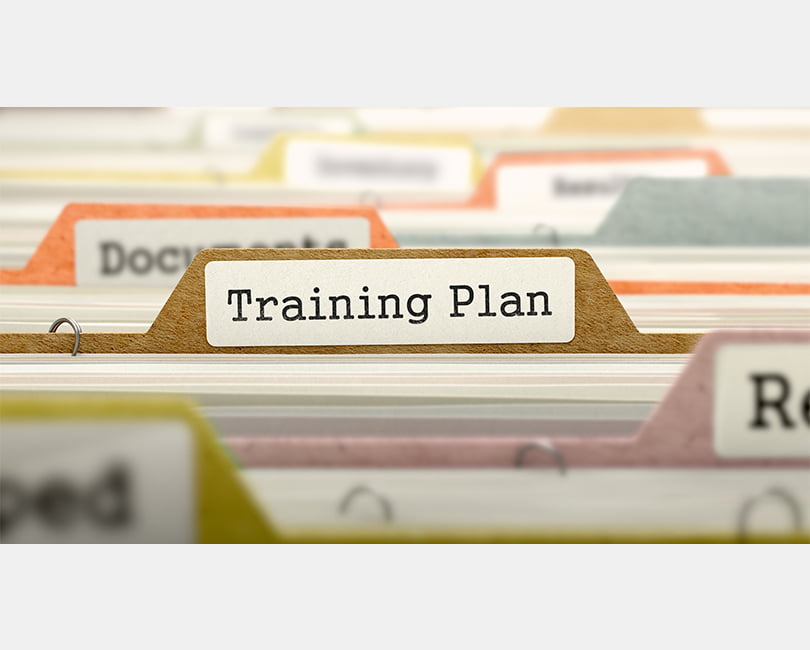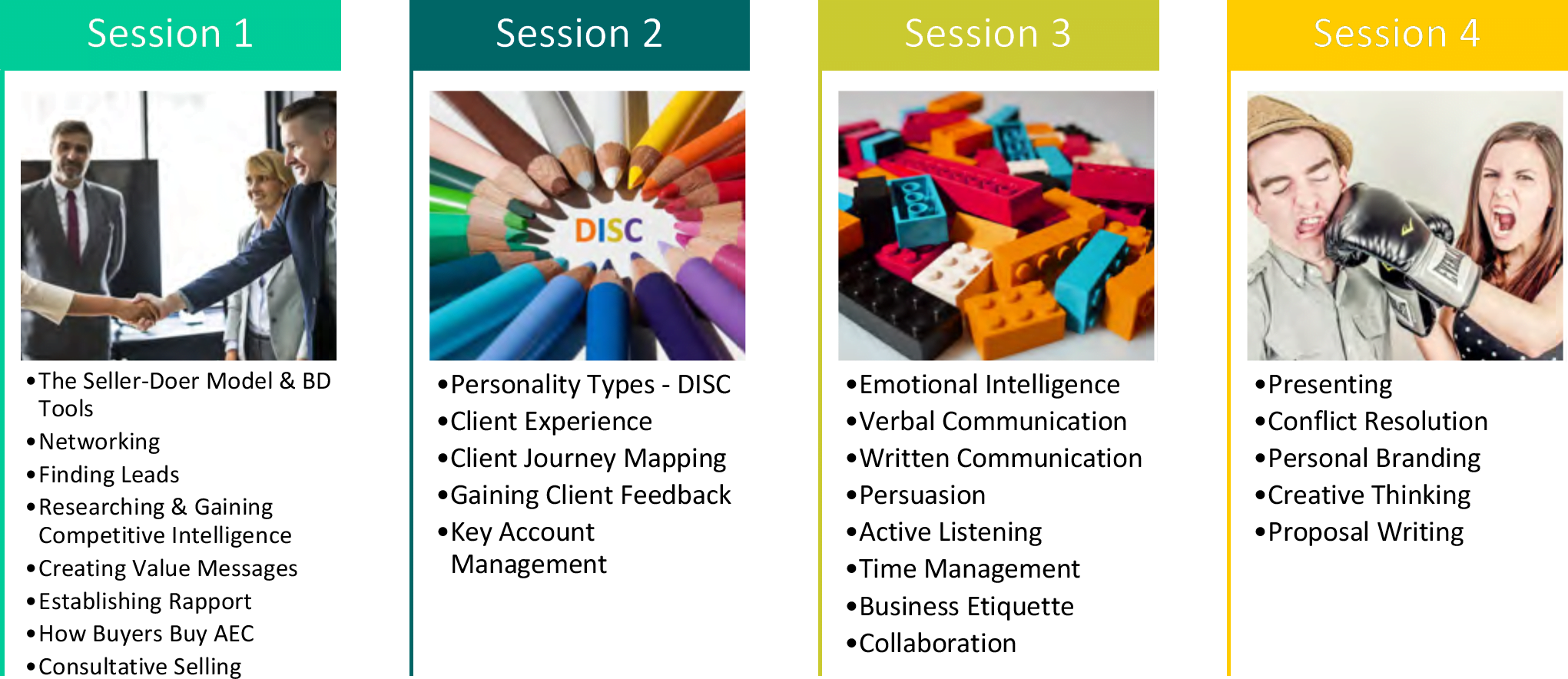Your Seller-Doers Need Training: What Should It Look Like?

Within the professional services industries, there’s an expectation that people in certain positions spend time generating new work while actually delivering that work. Attorneys and accountants must often “kill what they eat” – it’s the only way to become a partner. The same holds true for financial planners and insurance agents.
This is the essence of the seller-doer model – balancing billable hours with business development. The term “seller-doer” is derived from the order of the process – you must first sell the work before you can actually do the work. Some companies refer to professionals in this role as doer-sellers to signify that they spend more time doing than selling (which is often the case), although seller-doer is more commonly used.
The seller-doer model has always been part of the architecture, engineering, construction, and environmental industries. AEC firms of all shapes and sizes utilize technical professionals in myriad roles to support their firm’s business development efforts. Sometimes they act as the only business developers, and other times they work in tandem with dedicated business developers (often from non-technical backgrounds).
See Is the Seller-Doer Model Right for Your Firm?
The AEC Legacy of Bad Business Practices
Unfortunately, the AEC industry is notorious for embracing bad business practices that would be scorned in other industries. We love to promote people into roles for which they have little-to-no qualifications, training, or experience.
For example, take a successful engineer who is promoted to the role of project manager or department manager. What training do they have to manage people? Do they understand company standards, employment policies, and HR laws? Are they well-versed in financial management – a critical component of project management?
In many firms, the answer is a resounding “No!” So this successful engineer who excelled at designing structural or mechanical systems is suddenly tasked with running projects or departments, even though they have not been trained to do these tasks. This approach may (and that’s a big “may”) succeed in a single-discipline environment, but what if they are suddenly managing teams or departments with multiple disciplines?
Or how about the successful project manager (or department manager) who is promoted into the role of operations manager but with no training for that position? How will they learn to analyze and improve processes, determine hiring needs, recruit, staff projects and pursuits, improve efficiencies, eliminate bottlenecks, create policies, etc.? This is a far different role than managing a project team.
There’s a phrase for this insanity, and it is called the Peter Principle. Simply stated, the Peter Principle posits that “people in a hierarchy tend to rise to their level of incompetence,” like a successful engineer who fails at being a project manager. (Of course, this being the AEC industry, sometimes they get promoted into executive roles!)
Of course, the promoted professionals can succeed in these roles, but they need the proper training and onboarding for their new positions.
Now think about the seller-doer model, which is often a success/failure hybrid – requiring a competent, successful technical professional to spend part of their time doing something for which they have a minimal knowledge base – business development. In the span of a week or even a day, they can succeed in one role and exemplify the Peter Principle in another.
And yet this is a common, everyday practice in the AEC industry.
In fairness, business development is a somewhat tricky profession. It’s not like universities are offering bachelor’s degrees in BD. Successful business developers come from very diverse backgrounds. Sure, a marketing degree may offer sales components, but it is far broader and typically includes advertising, digital marketing, communications, public relations, management, business logistics, entrepreneurship, and statistics.
Dedicated business developers in the AEC industry get here from many different routes. Some have degrees in marketing or communications. Others have totally unrelated educational training but found their way into this industry and BD. Others cut their teeth on the technical side and found that they liked business development.
I know successful business developers with degrees in English and Zoology! I also have industry friends who found their way into business development after their “first” career on the technical side – the estimator-turned-business-developer and the structural-engineer-turned-project-manager-turned-business-developer.
The point is that someone’s background does not dictate whether or not they will succeed in business development.
Furthermore, just because someone has a technical background and extensive industry knowledge doesn’t mean that they will be effective in business development.
Thus the seller-doer paradox. Clients and prospective clients want to interact with people who understand their industry and can engage in technical discussions from the very first meeting. And while seller-doers have the knowledge and experience to engage in this dialogue, they rarely have the training needed to set-up and lead these conversations.
Training for Seller-Doers
So what training do seller-doers need?
The answer depends upon the amount of training that they have already received. If your firm is in the majority of AEC firms, your seller-doers have received no business development training. In fact, research from the Society for Marketing Professional Services (SMPS) found that two-thirds of firms don’t provide this type of training.
And that’s just crazy! How can your seller-doers expect to succeed – how can your firm have any expectation of success – if they are not given training in business development?
But which training is necessary? How do you prioritize topics? The SMPS research found that the top five most requested topics include:
- Getting more from client organizations
- Creating client capture plans
- Managing time
- Conducting research
- Improving networking skills
New research from SMPS revealed that the most important business development and marketing technique right now is networking, but within the next three years, networking will drop to number two and be replaced by client experience.
So networking is absolutely a critical skill for seller-doers to master, but so is the client experience. And because seller-doers are often on the front line of client relationships, they are the ideal people to drive client experience. But what, exactly, is it?
Hubspot defines Customer Experience (known as Client Experience on the professional services side) as “The sum of every interaction a customer has with your business.” So, understanding every single touchpoint is critical for seller-doers. What is driving the touch? What are the client’s specific needs? How can you add value to every interaction? How should you collect and aggregate this information?
SMPS also found that thought leadership will soon be the third most important BD and marketing approach. Again, seller-doers are ideally positioned to provide thought leadership because they walk the line between technical and BD-focus. They know the challenges that clients face, the value propositions your firm offers, and how these challenges have successfully been solved in the past.
Some newer approaches helping firms evolve their business development and marketing programs include personalized and account-based marketing.
Once again, seller-doers are uniquely positioned to embrace these approaches because they are on the front line of project work and new business development.
They know the existing clients. They understand their drivers and hot buttons and can help determine which customized messaging is most important. Likewise, they understand organizations and decision-making processes, allowing for tailored marketing campaigns to be developed and implemented.
But these approaches are useless unless the seller-doers have the knowledge base and foundational skills to do all these things.
Networking is an activity that requires a robust skill set, including the ability to initiate and lead conversations, establish rapport, ask meaningful questions (a key component of consultative selling), and generate customized value propositions. Seller-doers need these skills, but they must also have high levels of soft skills like emotional intelligence, verbal and written communication, business etiquette, and the ability to practice active listening.
Like any type of training, once-and-done BD training for seller-doers is often a recipe for failure. How often have you gone to a conference, learned great new ideas, returned to the office, become bogged down by deadlines, and lost all your newfound knowledge? It happens all the time – to all of us.
Training should be ongoing and should reinforce prior training while providing new content. Training needs to be intentional and meaningful. And it should be mandatory for your seller-doers. Furthermore, there should be some level of reinforcement happening in between formal training programs.
If your firm is already providing training, are you reinforcing the concepts being taught? If not, it is time for a refresher. How do you handle training for new employees or employees who missed the prior session(s)? Simply giving them handouts or providing a slide deck is not enough. Address these gaps first, then decide which topics you need to add to your program.
And if your firm has not provided any training for your seller-doers (like two-thirds of AEC firms), you have a blank slate. Start with the foundational skills listed above – those related to networking (which also relate to all business development):
- Networking skills
- Establishing rapport
- Asking meaningful questions / consultative selling
- Generating value propositions
- Understanding emotional intelligence
- Improving communications skills
- Utilizing proper business etiquette
- Practicing active listening
- Getting the most from client organizations
And don’t forget Client Experience training since that is where the industry is headed.
In my work with AEC firms, small and large, I’ve had some that prefer the once-and-done approach, usually focused on a few very specific topics. In some cases, it has been new content for the attendees; in other cases, it has been a reinforcement of content they’ve already learned.
I’ve conducted multiple sessions for other firms, typically including reinforcement of prior training. For instance, in working with seller-doers at a large engineering and environmental firm, I led 22 hours of training over several months. Here’s an overview of the training topics we covered:

The first session incorporated more traditional business development topics like networking, leading conversations, and consultative selling.
The second session was all about working with other people, including an understanding of the different personality types and a client’s experience with your organization.
Session three was focused on soft skills, and honestly, there is so little soft skills training in this industry that the content is relevant for everyone in the AEC workforce, not just seller-doers.
Topics for the fourth session were selected by attendees based on a survey asking what they hoped to learn but hadn’t yet.
This is an example of an AEC firm that believes so strongly in the role of seller-doers in their organization that they were willing to absorb the opportunity cost of having their front-line staff attend up to four full-day sessions. Many employees attended all four; others attended multiple sessions, but not all. New hires were brought in right after they were hired. In total, 70 employees were engaged in the training.
And this was just the foundation year. Reinforcement training is coming. Furthermore, separate training was also provided to their business development team.
Who Should Conduct the Training?
In this example, I was the outside trainer, and the sessions were filled with group activities and exercises to reinforce the concepts being taught. However, SMPS research has found that many firms are looking to their in-house business development and marketing staff to conduct training within their firms. For yet other firms, principals develop and lead the training.
There are many options for providing training, but too many firms view it as an expense, which is a horrible way to look at things. You must invest in your employees. Continually. And you cannot have any reasonable expectation of seller-doer success unless you provide them with the right tools.
Training is an investment, and whether or not you hire an outside trainer, send seller-doers to external programs (like the SMPS “Basics of Business Development in the AEC Industries” program), or utilize in-house employees, the biggest “cost” to the firm is the opportunity cost of having staff that could be billing hours on projects attending training instead. But the ROI of providing this critical training to your staff far outweighs any potential lost revenue or direct expense.
Invest in your firm’s future by providing training for your staff.
Would you hire a physician who didn’t attend medical school or have the proper credentials? Of course not.
So why in the world would you even consider sending your seller-doers into business development situations without equipping them with the required knowledge base? A fish out of water is easily identified. What kind of message are you conveying to your clients and prospects by sending an ill-prepared professional to establish a relationship with them?
Ready to implement a training program for your seller-doers or business developers? Stambaugh Ness not only provides customized training on several dozen business development and marketing-related topics, but we’ve also consulted with firms to help them establish internal programs led by staff members. Contact Scott D. Butcher, FSMPS, CPSM



